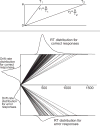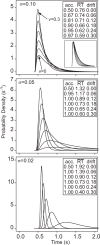The diffusion model is not a deterministic growth model: comment on Jones and Dzhafarov (2014)
- PMID: 25347314
- PMCID: PMC4429756
- DOI: 10.1037/a0037667
The diffusion model is not a deterministic growth model: comment on Jones and Dzhafarov (2014)
Abstract
Jones and Dzhafarov (2014) claim that several current models of speeded decision making in cognitive tasks, including the diffusion model, can be viewed as special cases of other general models or model classes. The general models can be made to match any set of response time (RT) distribution and accuracy data exactly by a suitable choice of parameters and so are unfalsifiable. The implication of their claim is that models like the diffusion model are empirically testable only by artificially restricting them to exclude unfalsifiable instances of the general model. We show that Jones and Dzhafarov's argument depends on enlarging the class of "diffusion" models to include models in which there is little or no diffusion. The unfalsifiable models are deterministic or near-deterministic growth models, from which the effects of within-trial variability have been removed or in which they are constrained to be negligible. These models attribute most or all of the variability in RT and accuracy to across-trial variability in the rate of evidence growth, which is permitted to be distributed arbitrarily and to vary freely across experimental conditions. In contrast, in the standard diffusion model, within-trial variability in evidence is the primary determinant of variability in RT. Across-trial variability, which determines the relative speed of correct responses and errors, is theoretically and empirically constrained. Jones and Dzhafarov's attempt to include the diffusion model in a class of models that also includes deterministic growth models misrepresents and trivializes it and conveys a misleading picture of cognitive decision-making research. (PsycINFO Database Record (c) 2014 APA, all rights reserved).
Figures



Comment on
-
Unfalsifiability and mutual translatability of major modeling schemes for choice reaction time.Psychol Rev. 2014 Jan;121(1):1-32. doi: 10.1037/a0034190. Epub 2013 Sep 30. Psychol Rev. 2014. PMID: 24079307
References
-
- Busemeyer J, Townsend JT. Fundamental derivations from decision field theory. Mathematical Social Sciences. 1992;23:255–282. doi: 10.1016/0165-4896(92)90043-5. - DOI
-
- Cox DR, Miller HD. The theory of stochastic processes. London, England: Chapman & Hall; 1965.
Publication types
MeSH terms
Grants and funding
LinkOut - more resources
Full Text Sources
Other Literature Sources

